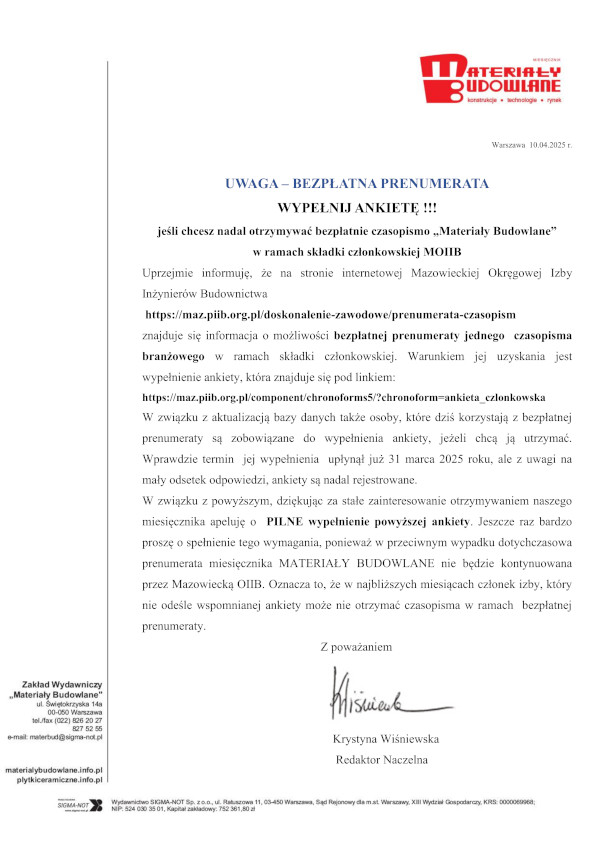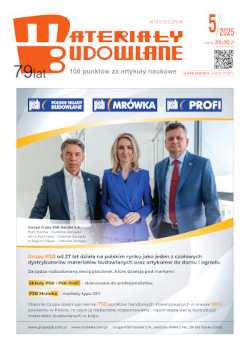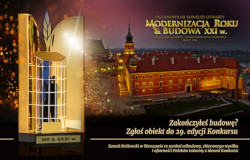dr inż. Józef Rabiega Politechnika Wrocławska,Wydział Budownictwa Lądowego i Wodnego
dr inż. Grzegorz Lesiuk Politechnika Wrocławska,Wydział Mechaniczny
mgr inż. Paweł Wątroba Inżbud, Przedsiębiorstwo Inżynieryjno-Budowlane INŻBUD spółka z o.o.
Autor do korespondencji: e-mail: Ten adres pocztowy jest chroniony przed spamowaniem. Aby go zobaczyć, konieczne jest włączenie w przeglądarce obsługi JavaScript.
DOI: 10.15199/33.2015.10.23
W artykule przedstawiono przykład wykorzystania elementów kompozytowych jako nawierzchni pomostu do obsługi taśmociągu w wiszącym moście technologicznym nad rzeką Odrą. Bezpośrednią przyczyną wymiany nawierzchni był awaryjny stan pierwotnej konstrukcji z blach ryflowanych pokrytych warstwą asfaltu lanego. Ze względu na zaawansowane procesy degradacyjne elementów kratowych przęseł mostu wiszącego konieczny był ich remont, zaś w strefie nawierzchni pomostu jego wymiana na elementy Fiberline typu kratka na chodnikach, a pod taśmociągiem typu Plank. Badaniom wytrzymałościowym poddano materiały typu kratka oraz panele typu Plank. Porównano właściwości mechaniczne obydwóch grup materiałowych i określono podstawowe parametry wytrzymałościowe. Badania potwierdziły zasadność stosowania ich jako elementów konstrukcyjnych w inżynierii mostowej.
Słowa kluczowe: materiały kompozytowe, wytrzymałość, most, pomost mostowy
* * *
Strength examination of the structural FRP-composite components used in bridge decks
This paper is devoted to the practical use of composite elements as bridge structural elements in the suspension bridge over the Oder river. The main cause of resurfacing the bridge platform was an obsolete condition of the corrugated steel sheet. The advanced degradation processes in trusses elements have been identified. The completion of maintenance activities are paving the complete replacement of the bridge on the type of grid elements Fiberline on the sidewalks, and the conveyor belt Plank type. The strength tests were performed using two exemplary types of materials structures; the structure of a "grid" and the panels "Plank" one. The mechanical properties of both material structureshave been comparedin the paper.The basic strength parameters havebeen also obtained. The strength test results have confirmed the legitimacy of using a such type of structures in bridge engineering.
Keywords: composite materials, strength, bridge, bridge deck
Literatura :
[1] Mara V., Haghani R., Harryson P., Bridge decks of fibre reinforced polymer (FRP):Asustainable solution, Construction and Buildings Materials, 50 (2014), 190 – 199.
[2] Bank L. C., Oliva M. G., Bae Han-Ug., Bindrich B. V., Hybrid concrete and pultruded-plank slabs for highway and pedestrian bridges, Construction and Buildings Materials, 24 (2010), p. 552 – 558.
[3] Hoffard T., Malvar L. J., Fieber – reinforced polymer composites in bridges, a state-of-the-art-report, Naval Facilities Engineering Command, May 2005, Canada.
[4] Knippers J., Pelke E., Gabler M., Berger D., Bridges with Glass Fibre – Reinforced Polymer Decks: The Road Bridge in Friedberg, Germany. Structural Engineering International 4/2010 s. 400 – 404.
Otrzymano: 26.08.2015 r.
Materiały Budowlane 10/2015, str. 76-78 (spis treści >>)





























